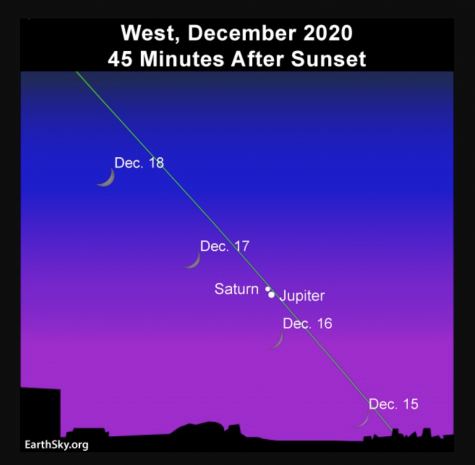Science Hub: “The Christmas Star”, Texas deep-freeze
The Science Hub is a newsletter to update you on science headlines.
The people of Ventura County have been blessed with a special gift this holiday season, for on Dec. 21st at around 6-8 PM, they will be able to view the “Christmas Star” in all of its glory, a sight that hasn’t been this observable in 800 years.
February 23, 2021
The “Christmas Star”: A celestial race between Jupiter and Saturn
On Dec. 21, 2020, the conjunction of Jupiter and Saturn, dubbed the “Christmas Star” was the most visible than it has been in nearly 800 years.
When astronomers refer to the conjunction, it is described as, “the meeting of objects in our night sky, and the great conjunction occurs between the two largest planets in our solar system: Jupiter and Saturn.”
The conjunction of Jupiter and Saturn occurs every 20 years, but the one on Dec. 21 was by far the most visible it has been since 1226. Jupiter and Saturn were only 0.1 degree apart, which is about 1/5 of the diameter of a full moon.
Many astronomers have named this specific conjunction of Jupiter and Saturn, the “Christmas Star,” because of a “belief that the biblical tale of the Star of Bethlehem could have been a planetary conjunction.”

Keith Salvas, the president and publicity director for the Ventura County Astronomical Society (VCAS), gave helpful insight on the “Christmas Star,” which he described as a, “rare treat.”
“We see the planets all the time as they move about our night sky. In actuality, they’re moving around the sun at different rates of speed. Every so often, from Earth’s perspective, they appear to get very close to each other. That’s what’s happen[ed] on Dec. 21, Jupiter and Saturn [were] so close they will almost look like one star,” Salvas continued.
Both planets were racing toward each other, and got closer and closer to looking like one bright star in the night sky.
Slavas described the Christmas star as a “celestial race…[where] Jupiter takes the lead and leaves Saturn in its cosmic dust,” and that the next occurrence of such sightings will not occur again until 2080.
-Nicole Stidham
Texas climate mimics 1989 deep-freeze
Over the past week, Texans have experienced quite the extreme weather stretch, with temperatures in some areas dipping below zero degrees. Multiple Texas towns hit their lowest temperatures since the last deep freeze in December 1989.
This “arctic outbreak” was caused by jet streams of cold air that are mainly contained in the North Pole. However, sometimes the jet streams move in waves, which causes them to blow the cold air towards other places; in this case the Midwest. As a result of “the strong area of pressure over the Southwest Atlantic”, the high pressure zones have focused on the Great Plains instead of heading east in its regular route.
Icy roads, miserable cold and power outages led to the death of at least 58 Texas citizens. Carbon monoxide related deaths occurred as a result of those huddling for warmth in their cars or an enclosed space, such as a garage. Carbon monoxide poisoning also has an increased chance of occurrence in severely cold weather. Others died of hypothermia and extreme cold, while a few lacked the oxygen they needed.
Unfortunately, this tragedy was not unprecedented, because of the previous occurrence in 1989. However, it gives us a glimpse of what our future may hold as the effects of climate disasters worsen and we remain unprepared.
The preparation in question would be the winterization of Texas’ energy infrastructure. Suggestions were made in an extensive report in 2011 after the previous cold wave. Some of those suggestions mentioned the installation of heating elements around pipes and increasing the amount of accessible reserve power before the storm hits.
Texas was once again unprepared for this cold stretch, and the failure to winterize energy sources left more than 4.5 million citizens without power. Those few families that never lost power saw outrageous electricity bills up to $15,000.
-Olivia Zoll
















